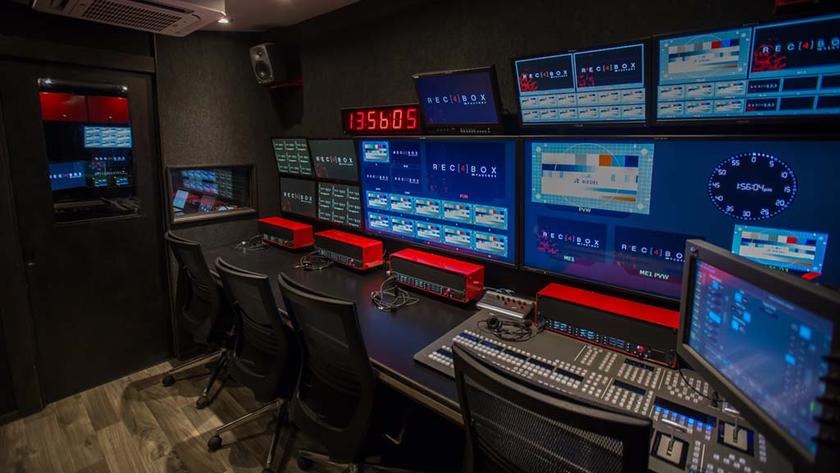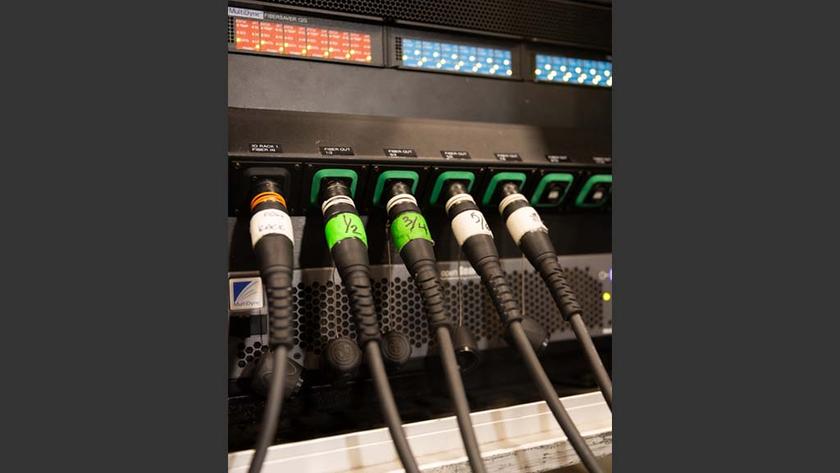Networked production systems for broadcasters
System integration revolves around one basic concept: workflow. The goal for any broadcaster is to streamline a host of components into one universal environment. This should accelerate productivity, reduce production time, increase global management of projects and media assets, and eliminate bottlenecks through transparent dataflow by deploying easy-to-learn, easy-to-use, cost-effective tools without sacrificing on the versatility and adaptability required for real-world operation.
Figure 1. This diagram illustrates the Incite network broadcast workflow. Click here to see an enlarged diagram.
Workflow means different things to different broadcasters. One might require a completely digital environment, while another requires a mixture that is tape-based and tapeless. One will want to implement a wide range of media formats, while others must incorporate a wide range of legacy equipment while pursuing new methods for acquisition and data transfers. Considerations must also be made for the networking infrastructure, the inclusion of regional affiliates and the interoperability of units in the field.
The different stages of workflow
Despite the different needs, work-flow can be reduced to specific stages that meet most medium- and large-scale facility requirements. These stages are story definition; acquisition; transcoding; media/clip browsing; proxy editing, in which journalists carry out basic browse/editing tasks at low resolution; craft editing, in which online editors finish preliminary edits begun by journalists or proxy editors; publishing; and playout. For each stage, the broadcaster requires specific tools to meet the work-flow requirements. All stages must be threaded together seamlessly with an effective, robust media and asset management system that allows dynamic, collaborative interaction between all of the components.
Media management
The essence of media management lies in the ability for users to share assets simultaneously. The way media sharing is handled could be considered the dominant factor in defining the effectiveness of an integrated solution. As media management is crucial at all stages, from ingest to playout, from clip logging to sequence editing, it is imperative to have centralized management with easy multiple points of access.
Incite, for example, is concentrating development effort on creating a global database or MAM architecture that can be accessed easily by any number of clients using one universal interface, the Incite Media Manager M2. This strategy not only provides a unified approach to media access and project management across the network, but also seamless collaboration between the components of the system and an architecture that is completely open towards Windows-based applications and third-party integration.
The need for a more dynamic, transparent approach to media management becomes increasingly important with the growing demand for IT technology in the newsroom. The facility becomes a gathering point of information, media and metadata that must be heroically organized on a daily basis. Newsroom applications, primarily responsible for defining assignments, need to communicate with the ingest, logging, editing and playout facilities in a smooth, efficient manner. Media must not only be ingested directly to central storage, but transcoded simultaneously into multiple formats for increased use across the network, distribution and archiving. Metadata as well must be accessible at different levels and must be customizable, editable and easily updated globally.
To do this, protocols, gateways and monitor/automation applications must be implemented to track the various tasks throughout the system where the story is being collectively assembled. As an example, Incite has chosen to implement a MOS gateway for communication with external newsroom applications; a unique Master Clip gateway that tracks the creation of media, associated proxy formats and metadata creation/modification; task management services that handle network-based rendering, transcoding and mixdown; and automation protocols for ingest/playout event handling.
Handling different formats
Integrated solutions must also be able to work with a variety of formats over a wide range of bandwidths. Media acquisition can be anything from analog input, SDI, SDTI transfers, IEEE1394, live feeds digitized directly to central storage, or new portable media technologies such as video disk units and other recordable devices. Automation tools can monitor ingest folders generating multiple and/or cascading transcoding tasks to create alternative formats while media is being digitized or transferred. Network-intelligent transcoding tools and file rewrapping with no recompression are also important for gathering footage from the field, affiliates or third-party applications.
Multitasking
Simultaneity is another beneficial aspect of system integration. An example might be providing the ability to log and edit live feeds while they are in the process of being digitized to central storage through SDI or other inputs. Shot selection and metadata insertion, such as comments and clip markers, can occur while the sports event is in progress and being captured to disk. Taking this a step further, the journalist or craft editor monitors clip selection and begins building the sequence immediately. The result is a finished story before the event’s closing bell, providing an enormous reduction in production time. For finished sequences, output files can be compiled using what Incite calls network-based video printing. The concept is similar to any network-based printer, only this is video-based rather than paper-based. The service eliminates the need for the editing workstation to perform the actual mixdown, with the added advantage that the progress of the mixdown can be monitored from any network workstation. In addition, the output file can be added to running orders for immediate playout via the centralized video server. During mixdown, the file can be simultaneously trans-coded in alternative formats for distribution, such as DVD or webcasting. The unique ID of the file is preserved for the newsroom application that can playout the file in association with other newsroom elements, such as text scripts and real-time graphics.
SAN technology
To bolster simultaneous, distributive multitasking, different storage/networking strategies can be employed to augment the number of logging, proxy editing and craft editing workstations available. Storage Area Network (SAN) solutions provide mission-critical throughput at high-bandwidths for high-resolution craft editing. Network-Attached Storage (NAS) can be employed for real-time editing and media sharing over Gigabit Ethernet at lower bandwidths or full-resolution DV, allowing more cost-effective expansion. NAS is particularly exploited by Incite through the development of its NAS-File Server, which regulates network traffic, operating in a similar manner to metadata controllers (MDCs) used with SAN technology. Both networking systems provide full redundancy, volume control, speed regulation and simultaneous shared access to media. They can be configured to provide cross-access, allowing users to browse/edit at different bandwidths.
To support proxy/high-resolution editing strategies, media management again becomes a crucial factor. To begin with, automated ingest is not enough. Automated transcoding must also take place, creating alternate proxy files that are dynamically linked to the high-resolution media. The dynamic link means projects can be opened at either resolution, depending on the task requirements. For example, a journalist begins the sequence using a proxy codec, while the craft editor loads the same project at full or high resolutions. Using transcoded media, optimized for the Internet, also allows for easy transfers across pipelines or FTP. Preliminary edits can be created at one station then forwarded to the main facility as an EDL for online assembly and finishing.
Brady Woodson is director of communications for Incite.
Get the TV Tech Newsletter
The professional video industry's #1 source for news, trends and product and tech information. Sign up below.













